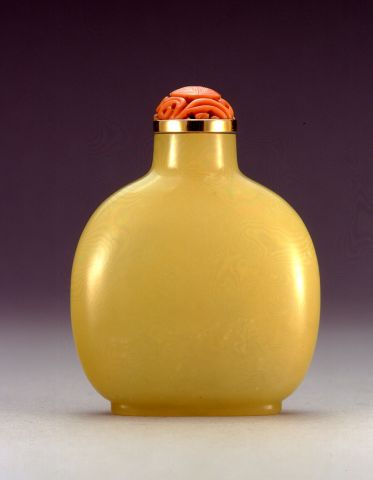
Bottle ID: 908
FLATTENED, ROUNDED
Date: 18th Century
Height: 61 mm
Nephrite, extremely well hollowed, of flattened rounded form, with sloping shoulders and a wide mouth and well formed foot rim; the material of a translucent yellow color resembling steamed chestnuts.
Probably Imperial, attributed to the Palace Workshops, Beijing.
Similar Examples:
Moss, Hugh, Victor Graham and Ka Bo Tsang. A Treasury of Chinese Snuff Bottles - The Mary and George Bloch Collection, 1995, Vol. 1, pp. 430-431, no. 168.
Kleiner, Robert. Treasures from the Sanctum of Enlightened Respect. Chinese Snuff Bottles from the Collection of Denis Low, 1999, p. 67, no. 54.
Sotheby's, London, March 23, 1988, lot 179.
Provenance:
Clare Lawrence Ltd.
The Monimar Collection
Sydney L. Moss Ltd.
Exhibited:
Annual Convention ICSBS Hong Kong, October 1996
Christie's, St. James's, London, June 1996
Published:
Lawrence, Clare. Miniature Masterpieces from the Middle Kingdom - The Monimar Collection of Chinese Snuff Bottles, 1996, pp. 168-169, no. 78.1
Moss, Paul. Documentary Chinese Works of Art: In Scholars' Taste, 1983, pp. 172-173, no. 113
Nephrite that is truly yellow in colour is rare. To hollow out a bottle until it is translucent as this one is, would tend to leave the stone weak in colour and perhaps uneven. Yet the strength of this colour is evident despite the thinness of its walls. There is no reason to adorn this bottle in any way; the carver is aware that he has created a masterpiece by using a superb piece of stone and hollowing it out until it cannot be hollowed further without damage. Its simple form is deceptive. In fact it is so correctly proportioned that even removing the footrim would have destroyed the subtle balance of purity and form. Sir Percival David translated the Kaogu Yaolun ("Essentials of Chinese Connoisseurship") written during the Ming dynasty, where the comments about jade are pertinent:
"White jade: The most valuable stones are of mutton-fat colour. Those with the colour of ice or of rice porridge, or the colour of fat or of snowflakes, are next in quality. Yellow jade: Stones with the colour of the chestnut kernel, known also as sweet yellow, are the most valuable...".
< Back to full list

 English
English 中文
中文